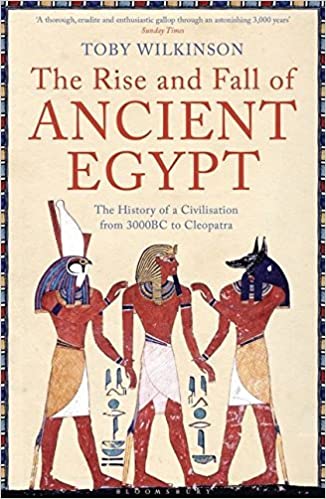Book Review: The Rise and Fall of Ancient Egypt: The History of a Civilisation from 3000 BC to Cleopatra
By Toby Wilkinson
Reviewed by Sandra Alvarez
"From earliest times, the Egyptians were adept at recording things as they wished them to be seen, not as they actually were." (p.56)
Ancient Egypt remains one of the most popular periods in history today thanks to museums filled with its golden treasures and stunning funerary artifacts, numerous TV programs, and endless Hollywood mummy films. I have always had a soft spot for this vibrant and death-obsessed culture that dominated the ancient landscape for over 3,000 years. It continues to captivate and intrigue people centuries after its demise. In preparation for our upcoming issue on the Middle Kingdom, I decided to read The Rise and Fall of Ancient Egypt: The History of a Civilisation from 300 BC to Cleopatra to get better acquainted with the ancient Egyptians.
Renowned Egyptologist, Toby Wilkinson, has written numerous books on ancient Egypt but this behemoth of a book stands out as a great introduction to a complex topic. It covers over 3,000 years of history in a whopping 646 pages. The book follows a traditional chronological format, but its aim is to delve a little deeper into the less celebrated side of ancient Egypt's history. While many Egyptologists are happy to focus on recounting the glories of ancient Egypt – its awe-inspiring pyramids, tremendous cultural impact, and artistic achievements, Wilkinson eschews this rose-colored glasses approach and is not afraid to tackle its ugly side.
"The aim of this book is to give a fuller and more balanced picture of ancient Egyptian civilization than is often found in the pages of scholarly or popular works." (P.10)
And in that - he is successful. Wilkinson touches on some grim themes and difficult topics such as human sacrifice in the Old Kingdom, where early rulers had their entire court strangled to join them in the afterlife. He also discusses ancient Egypt’s role as the first true "nation-state", a highly xenophobic society where kings maintained the fiction of ancient Egypt being better than everyone else, and where the price for unity and an isolationist policy was harsh, and often aggressive, authoritarian rule – a culture where kings violently subjugated not only foreigners but their own subjects.
The Rise and Fall of Ancient Egypt also explores changes in royal administration, such as the development of the role of vizier, and the decision by the Fifth Dynasty to move from placing family connections in high-level positions to the use and promotion of professional bureaucrats. It examines how this change both bolstered and eventually weakened Egyptian rule due to the increase in administrative bloat and regional fragmentation.
Naturally, religious belief is a huge component of this book, since, for the ancient Egyptians, religion played an instrumental role not just in life, but even more so in death. Wilkinson discusses the importance of religion and kingship – which were closely intertwined – and the shift from royal to more inclusive worship and burial practices through the rise of the cult of Osiris, giving birth to the idea of an afterlife for all. He looks at one of the most extreme examples of this relationship in the heresy of the infamous pharaoh, Akhenaten.
From the cultural flourishing of the Middle Kingdom’s art and literature to the glories of the New Kingdom to Egypt's decline under Ptolemaic rule and eventual fall under Roman control, The Rise and Fall of Ancient Egypt adeptly covers political intrigues, religion, economics, social attitudes, foreign policy, and so much more. It explains what the ancient Egyptians did exceptionally well, why their power lasted as long as it did, and what failings ultimately caused this astonishing civilization to crumble.
I must admit that initially, I was a bit hesitant to pick up this book. In spite of its daunting size, The Rise and Fall of Ancient Egypt was written in an approachable and accessible way. I've read overviews that attempted, much like this one, to cover a lot of ground and ended up being painfully dry and boring. This book was truly a pleasant surprise – not only did I look forward to picking it up every day, but I found it to be quite the page-turner! It contains many beautiful color plates and an exhaustive bibliography for those interested in pursuing niche corners of ancient Egypt. I highly recommend this book to anyone who wants a good entry point into this period and solid synopsis of ancient Egyptian history.
Want to learn more about ancient Egyptian history?




